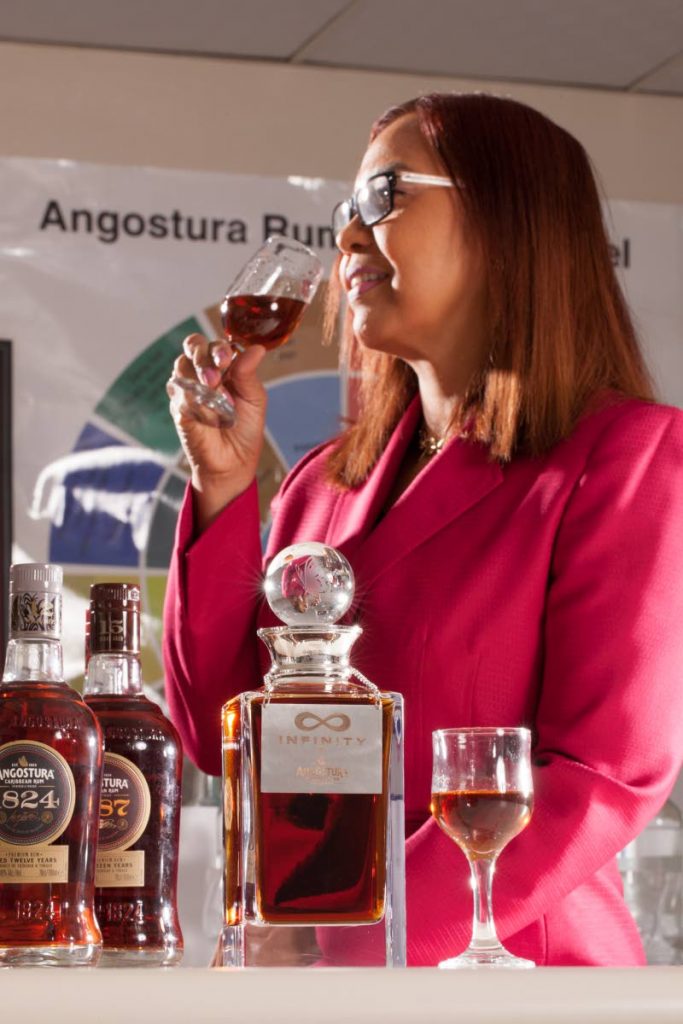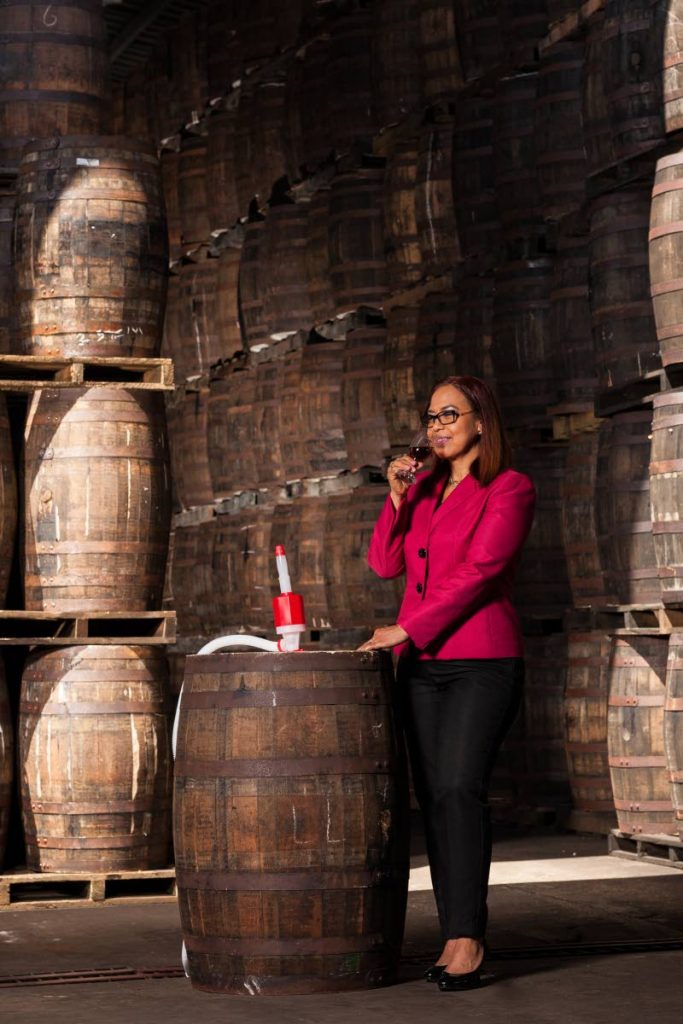Carol, the master blender

Carol Homer-Caesar is the only female master blender in Trinidad and Tobago. And as the manager of blending and quality assurance at Angostura Ltd, she has been in the rum-blending business for two decades.
When she began working at Angostura 23 years ago, Homer-Caesar started as the manager of the laboratory responsible for the quality control of the raw materials, as well as the in-process samples and finished products.
“You have to have an in-depth knowledge of the rum blends. About five years into my job, having started in 1995, I started looking at blends, evaluating them and looking to see how we can improve them because through testing I have a good sense of the aged rums and what we call congeners, and they are really components within an aged rum. So in doing that, I started blending and in 2000, we wanted to bring out a rum to mark the year 2000, so we looked at 1919, one of the first blends that I worked on. And it actually rolled into 2001 because of the choice of rums and the aging etc. That’s when I started blending.”
Five years ago, Homer-Caesar earned the title of master blender, but she said before this blending was a team effort.

“We have a master distiller John Georges, and as the blender responsible for new product development which became part of my portfolio in 2001, I started blending rums. And we would all be blenders in the rum but we never really came out and said who was the master blender in the past. We always worked as a team. But about five years ago I got the actual title of master blender. But it was always a team of blenders with the focus on the master distiller.”
Homer-Caesar was trained in Scotland, where she learnt sensory valuation of spirits, not just scotch whisky but all types of spirits, rum included. She also trained in brewing and distilling spirits at Alltech in the US. “It’s really a craft where a lot of it is dependent on you and having a chemistry and quality background. I am able to analyse the aged rums and know when we put certain rums together what will be the outcome. The sensory evaluation helps because at the end of the day, you could test the rum but it’s how it tastes and how it smells that plays really a big factor in evaluating a rum and saying this is the rum we can go with.”
And who determines what qualifies one to be a blender? Homer-Caesar said that is based on the blends the person has done and the awards they would have received. “Depending on your knowledge, skills, training. At Angostura, I do a lot of sensory evaluation training, not just internally but also with the West Indian Rum and Spirits Association headquartered in Barbados. I do a lot of technical training for them and part of it is sensory evaluation, taking people through how you could define a heavy rum, a medium rum, a light rum, what sort of taste is on the palate, what is the finish, what category you could put the rum in, whether it is premium, super premium or ultra premium. So it was based on the experience from blending, the training that I received externally as well as internally and my experimentations with aged rums as well.”

Homer-Caesar added that the extensive research which she did in aged rums and the rums her company produced for international competitions assisted her in becoming a successful blender.
Angostura won four awards just last week at the SIP awards, an international spirits competition in the US. Homer-Caesar revealed organisers don’t use trained judges to judge rums. They take people straight off the streets to do blind tasting. Angostura won double platinum, double gold, gold, double silver, silver and bronze awards for its Angostura 1824, Angostura 1919, Angostura Reserva, Angostura five year old, Angostura seven year old and Angostura 1787.
Prior to that Angostura won some 180 awards for its international rum range at the International Wines & Spirits awards in UK, World Spirits Awards in the US as well as SIP awards.
Homer-Caesar said all rum distilleries and aging warehouses have a signature taste. But what sets Angostura rums apart from the rest is a yeast cultured at its micro-biology lab.
“The interesting thing about this yeast is that we actually have the original yeast in a yeast bank in the UK and every year we will send samples of part of the yeast we have here in TT to ensure there are no mutations with the yeast. And it is the same as 20 or 40 years ago. So that determines the type of rum. Through the fermentation you would get the alcohol at eight per cent and there is where the flavours start. So Angostura has a unique yeast and this is the very first stage of rum-making. Then it goes into distillation. We have a five-column still, and this is where we go through several rectifications to clean up the rum and where we make our natural spirits. And this is where it goes from eight per cent to 96 per cent based on the column, the heating, cooling and the distillation process. After that it is diluted to around 66 to 70 per cent and it is placed in a once-used oak bourbon cask purchased from Kentucky, US, to age.
“Our aging warehouses are environmentally controlled in terms of our humidity and temperature and the manner in which we stack our casks plays an important roll, as well as the height of the ceiling and the amount of airflow coming in and out of the warehouse.”
For quality control, Homer-Caesar said they would monitor that entire process, from the yeast to the fermentation and distillation to aging, then draw samples to ensure it is aging properly and the conditions are right.
She said Angostura has over 200 years of blending expertise from the Siegert and Fernandes families, that is mixed with modern technology, adding to their uniqueness.
Questioned as to what someone looks for when buying a rum, Homer-Caesar said it depends on whether the person is a first time drinker of rum or a beer drinker. “Usually first time drinkers start with a white rum because it is light and has less congeners. You will look for the palate, whether it is filling the palate or lingering, whether there is a bitter after-taste, whether it is smooth and going down the palate well, whether you need to use a mixer, it all depends on the demographics. Females may prefer white rums, which is a light rum, while the male drinker may prefer a heavier rum. 1824 is a medium to heavy rum. It’s a luxurious blend that connoisseurs prefer because they like their rum neat and flavourful. The 1787 is also a neat rum, but one where all notes and layers can be found in this medium to heavy body rum, while the light to medium body rums are the 1919 and seven-year-old.”
As for the sale of bulk rum to customers, Homer-Caesar said they may buy it as aged rums and convert it to whatever rums they want, and some will indicate the origin is Trinidad or the Caribbean. She said in the US, Angostura has no control on how foreign buyers use bulk rum. She said sometimes they may just add a few things to it and then co-pack it, bottle it and dilute it.
Angostura exports bulk rum to the Caribbean, US and Europe, and by the cases, its exports extend to Asia, Africa and Australia.


Comments
"Carol, the master blender"